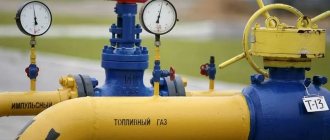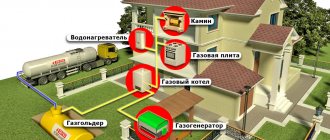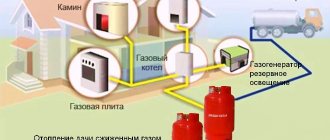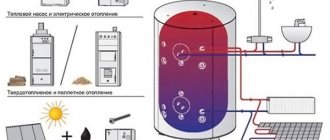Autonomous gasification has two significant columns in the estimate: installation of a gas tank and annual fuel consumption. We will tell you how much you will spend on liquefied petroleum gas (LPG) when living in an area of 50 to 800 m2.
The entire article in 1 table
| Popular house sizes | Gas consumption per month | Gas consumption during the heating season (7 months) | Gas consumption per year |
| 100 m2 | 316 l | 2,212 l | 3,802 l |
| RUB 5,624 | RUB 39,368 | 67,000 rub. | |
| 150 m2 | 475 l | 3,325 l | 5,703 l |
| RUB 8,455 | RUB 59,185 | 101,000 rub. | |
| 200 m2 | 633 l | 4,431 l | 7,603 l |
| RUB 11,267 | RUR 78,869 | 135,000 rub. |
LPG at a price of 17.80 rubles/l as of 01/29/2019.
Gas consumption calculator for home heating
LPG consumption can be calculated in 3 ways: by boiler power, house area and the Soviet formula (27 liters per m2 per year). All options give an average result, because they are divorced from real living conditions.
We made a calculator based on heat loss at home. The room warms up correctly if the heating compensates for the thermal energy that the building loses through the roof, doors, walls, windows per unit of time.
The calculations include the height of the ceilings, the presence of an attic or basement, and building materials with different heat losses:
- foam blocks - 32.7 kW/m2;
- brick - 27.6 kW/m2;
- wood - 26.1 kW/m2.
Calculate online
House area (m2)
Ceiling height (m)
Attic
Basement
House material
How exactly does the calculation take place?
The final indicator of LPG consumption per year is derived using several formulas:
- We calculate the gas consumption without hot water (kW/h): house area × ceiling height × heat loss of the material × attic and basement coefficient.
- We find the gas consumption with DHW (kW/h): consumption without DHW × coefficient for DHW.
- We convert the kW/h indicator to Kcal/h, then to m3/h, then to l/h.
- We calculate the annual consumption: l/h × boiler operating hours per year.
In the calculation process, we take into account a number of indicators:
- The coefficient for DHW accounting is 1.15.
- The coefficient of the attic and heated basement is 0.95.
- The coefficient of the attic and unheated basement is 1.
- Coefficient without attic + heated basement - 1.
- Coefficient without attic + unheated basement - 1.05.
- The coefficient without an attic and without a basement is 1.1.
- The coefficient for converting energy (kW) into calories (Kcal) is 1.163.
- The conversion factor from m3 to liters of LPG is 2.37.
- Boiler operating hours per year - 2,265.
- Boiler efficiency is 0.92.
Unaccounted variables for gas consumption in a private home
The calculator still produces an average result. For accurate forecasting, much more data is needed:
- Required room temperature.
- Average temperature of the coldest week of the year.
- The number of windows, their height and width.
- Ratio of window to floor area: 10–50%.
- Window type: regular double glazed, double glazed, double glazed.
- Number of floors, upper and lower floors.
- Characteristics of external walls:
- masonry of 1-3 bricks with a thickness of 25–76 cm;
- log house made of logs with a diameter of 20–25 cm;
- log house made of timber 10–20 cm thick;
- frame wall 20 cm thick (board, mineral wool, board);
- foam concrete 20–30 cm thick.
Important adjustments are made by in-house gas equipment:
- number of burners on the stove;
- presence of an oven;
- real (not nameplate!) power of the gas boiler;
- device type: standard or condensing boiler.
A condensing boiler uses the potential of water vapor from gas combustion products. The equipment uses the generated heat as efficiently as possible and reduces fuel consumption by 15%.
By the way
If you want to determine the gas consumption for your home taking into account all the data, contact an engineer.
Count for me
Device Features
When choosing a device, it is necessary to take into account its cost-effectiveness and efficiency. As practice shows, the most common type of device is gas boilers, since they operate using fuel, which is available in any home. Thanks to modern progress, gas is available even in small villages. Therefore, people use it for different purposes: cooking, heating the house, heating water and more.
During its operation, a boiler of this type feeds a significant amount of fuel. This must be taken into account when installing and using it in your home. But there are many ways to help reduce them
To do this, it is important to take into account the design features, model, brand and other characteristics of the unit. Then it will be easy for you to choose the one that is the best option for your home, which will allow you to save gas costs and money on its payment.
Heating a house with a gas holder
It is better to calculate the required amount of gas in relation to the barrel. That is, how long will each container last for different room sizes?
The gas tank is selected according to the number of refills. The optimal rate is 1-2 times a year. At a minimum, the tank should last for 7–8 months—the heating season.
Liquefied gas consumption per season
According to SP 131.13330.2012 Construction Climatology (updated edition of SNiP 23-01-99), the heating season in Russia is 207 days. This is approximately 7 months.
Also important information: the boiler does not operate around the clock. On average, heating operates 10 hours a day.
We carried out calculations based on the initial data:
- brick house without attic and basement;
- floor height 3.2 m;
- The efficiency of the gas boiler is 92%.
Indicators for refueling frequency are averaged. We assumed the same fuel costs for each month. In reality, residence may be seasonal or temporary, and consumption differs depending on the season.
The ratio of the area of the house and the volume of the gas tank (GG)
| GG volume (m3) | Full gas charge (l) | How long will gas last (months) | |||||||
| 50–100 m2 | 150 m2 | 200 m2 | 250 m2 | 300 m2 | 350–450 m2 | 500–600 m2 | 800 m2 | ||
| 3,802 l/year | 5,703 l/year | 7,603 l/year | 9,504 l/year | 11,405 l/year | 17,107 l/year | 22,809 l/year | 30,412 l/year | ||
| 2.5 | 2 125 | 6.7 | 4.5 | 3 | 2.7 | 2 | 1.5 | 1.1 | 0.8 |
| 2.7 | 2 295 | 7 | 5 | 3.6 | 3 | 2.4 | 1.6 | 1.2 | 0.9 |
| 4.6 | 3 910 | 12 | 8 | 6 | 5 | 4 | 2.7 | 2 | 1.5 |
| 4.8 | 4 080 | 12.8 | 8.5 | 6.4 | 5.1 | 4.2 | 2.8 | 2.1 | 1.6 |
| 4.85 | 4 112 | 13 | 8.6 | 6.5 | 5.2 | 4.3 | 2.9 | 2.2 | 1.6 |
| 5 | 4 250 | 13.4 | 9 | 7 | 5.4 | 4.5 | 3 | 2.2 | 1.7 |
| 6.4 | 5 440 | 17 | 11.4 | 8.5 | 6.8 | 5.7 | 3.8 | 2.8 | 2.1 |
| 6.5 | 5 525 | 17.4 | 11.6 | 8.7 | 6.9 | 5.8 | 3.9 | 2.9 | 2.2 |
| 6.6 | 5 610 | 17.6 | 12 | 9 | 7 | 6 | 4 | 3 | 2.2 |
| 8.6 | 7 310 | 23 | 15 | 11.5 | 9 | 7.7 | 5 | 3.8 | 2.9 |
| 9.1 | 7 735 | 24.4 | 16 | 12 | 9.7 | 8 | 5.4 | 4 | 3 |
| 9.15 | 7 777 | 24.5 | 16.4 | 12.3 | 9.8 | 8.2 | 5.5 | 4.1 | 3.1 |
| 9.6 | 8 160 | 25.7 | 17 | 13 | 10 | 8.6 | 5.7 | 4.3 | 3.2 |
| 10 | 8 500 | 27 | 18 | 13.4 | 10.7 | 9 | 6 | 4.5 | 3.4 |
Interpretation of colors in the table:
| irrational | Capacity supply is too large or too small |
| optimal | For seasonal or permanent residence with 2 refills per year |
| perfect | It is best to install for the heating season |
| with reserve | One-time refill is enough for a year |
Houses with an area of 800–1000 m2 are served by:
- gas tanks with industrial volumes of more than 10 m3 (installation is more complicated);
- two containers located side by side (8.6, 9.1 or 9.15 m3).
Wall boiler
Gas boilers can not only be installed on the floor, but also mounted on the wall. If the second option is used, then the device operates using electricity. Therefore, it is necessary to take this into account when calculating the costs of its maintenance.
Electrical energy facilitates various processes in the system. This includes pump circulation, automatic system adjustment, ignition, fan, etc. Therefore, there is no way to avoid costs of this type in a wall-mounted gas boiler.
But few people know how much electricity a gas boiler consumes. It is quite logical that this question arises. Electricity consumption at different stages of its operation differs. So, in operating condition this value is 65 W, and as soon as it ignites, the electricity consumption almost doubles and amounts to 120 W.
It is also worth considering additional elements in the unit. If there is a fan, then it also requires electricity to operate. In this case, the cost of operating the device increases by 30-35 W. By summing up these values, you can get how much electricity a gas boiler consumes.
Liquefied gas consumption per month and year
Let's go over the costs of refilling a gas tank for houses of different sizes. We use the LPG price current at the beginning of 2022 - 17.80 rubles/l. This is the cost of refueling in our company.
| House area (m2) | Gas consumption per month (l) | Gas price per month (RUB) | Gas consumption per year (l) | Gas price per year (RUB) |
| 50–100 | 316 | 5 624 | 3 802 | 67 675 |
| 150 | 475 | 8 455 | 5 703 | 101 153 |
| 200 | 633 | 11 267 | 7 603 | 135 533 |
| 250 | 792 | 14 097 | 9 504 | 169 171 |
| 300 | 950 | 16 910 | 11 405 | 203 009 |
| 350–450 | 1 425 | 15 365 | 17 107 | 304 504 |
| 500–600 | 1 900 | 33 820 | 22 809 | 406 000 |
| 800 | 2 534 | 45 105 | 30 412 | 541 334 |
Thus:
- gas consumption for heating a house of 100 m2 is 68 thousand rubles per year;
- gas consumption for heating a house of 150 m2 is 101 thousand rubles per year;
- gas consumption for heating a house of 200 m2 is 136 thousand rubles per year.
Real gas consumption: reviews from gas tank owners
We have selected examples of using autonomous heating on the ForumHouse forum. Owners have different experiences. In the project, the insulation of the house, the climate, the needs of the residents and the quality of the boiler are important.
Case 1. The user actively spends LPG - permanent residence with regular showers. A 2,300 liter refill lasts for almost 2 years at a room temperature of at least 21°C. Costs are reduced by using the fireplace 6 times a month - 3 hours of burning and 9 hours of smoldering.
Consumption per year: 20,700 rubles (1150 l at 18 rubles/l). House 125 m2.
Quote from user +Egoza from the ForumHouse forum
Case 2. The user has well insulated the house and installed a low-temperature boiler. In winter I did not take away the hot water supply. Daytime temperature in the rooms is 23°C, night temperature is 20°C. Daily gas consumption is from 6 to 12 liters.
Consumption per year: 15,000 rubles (1000 l at 15 rubles/l). House 120 m2.
Quote from user Khozain2000 from the ForumHouse forum
Case 3. The user heats the house and garage. There are problems with insulation: heat loss through the door, floor and ceiling. Gas consumption is about 15 liters per day. Daytime temperature in the rooms is 22°C, night temperature is 19°C.
Consumption per year: 81,000 rubles (5,475 liters at 15 rubles/l). House and garage 165 m2.
Quote from user AntonVT from the ForumHouse forum
Quote from user AntonVT from the ForumHouse forum
Case 4. The user lives at his dacha on weekends. Only the first floor of the two is heated. On weekdays, if there are no residents, the temperature is automatically maintained at 7°C. The hot water supply has not yet been started. Uses remote heating control via a ZONT room thermostat with its own SIM card.
Consumption per year: 33,900 rubles (2,275 liters for 14.90 rubles/l). House 190 m2.
Quote from user Dimabol from the ForumHouse forum
Advantages of "blue fuel"
The low price of one cubic meter of fuel at 5-6 rubles makes gas the most economical option for heating premises in most regions of the Russian Federation. The composition of blue gas is characterized by an extremely low content of sulfur inclusions, which determines the high energy efficiency of the fuel. In addition, the combustion of clean fuel practically does not pollute the air, due to which gas is considered one of the environmentally friendly sources of energy.
Another important factor in favor of “blue fuel” is the absence of corrosion of the metal parts of the boiler generator. In addition, during operation the generator practically does not emit soot and soot, which eliminates the need for periodic cleaning of chimneys. The list of advantages of gas generators ends with their operating time, which significantly exceeds the production cycle of other energy sources.











